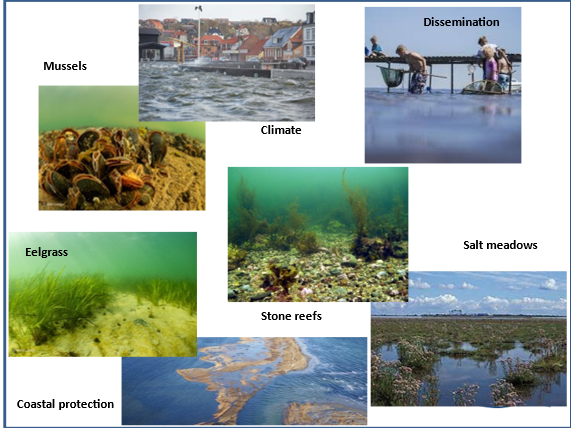Coastal LIFE - Nature restoration in the coastal zone and on salt marshes
Coastal lowland nature is Denmark's most important contribution to world biodiversity. In the project coastal habitats that previously existed in large measures in the shallow coastal areas in Denmark will be recreated in four project sites. On land Atlantic salt meadows will be restored as a central natural habitat type in Denmark together with coastal lagoons in the transition zone between land and water. In the shallow waters outside the salt meadows stone reefs, inlets and eelgrass – mussel – and oysterbeds will be re-created.
Through this large-scale nature restoration, we achieve a number of significant effects on biodiversity, climate and environment.
 The different elements in the project
The different elements in the project
The primary goal is to improve conservation status for the protected habitat types and bird species in the four Natura 2000 sites. The four project sites consist of low laying former salt meadow areas which now are in agricultural use and adjacent shallow marine water bodies protected by the Habitats Directive and the Birds Directive. 11 natural habitat types and 9 protected bird species at the four sites are in unfavourable conservation status at EU and national level and threatened in occurrence and distribution.
The project will remove/immobilize significant amounts of nutrients thus contribute to achieve goals for an improved water quality.
Areas that are currently in agricultural use will be extencified reducing the direct export of nutrients to the aquatic environment and the new salt marshes will absorb nutrients both from inflowing water from the hinterland and from the fjord waters, which in the future will flood the salt marshes at high tide. Further stone reefs, eel grass - and mussel beds, will absorb a significant amount of nutrients from the water permanent or temporary.
Restoration of a more original and dynamic coastal zone will also have a number of derived climate effects. Establishing wetlands will reduce carbon emissions. When the soil is not cultivated, the carbon pool in the soil will build up. Higher water levels in the fresh meadows will reduce the CO2 release and the re-establishment of saline-affected outer salt meadows and the re-establishment of lagoons and small saltwater lakes will significantly reduce the CH4 release that currently takes place in the nutrient-rich fresh habitats. Furthermore, at high tide there will be an increased transport of sediment into the salt marshes, whereby carbon will be stored in the soil.
In the shallow water, eelgrass beds are re-established sequestering and storing carbon, and outside the eelgrass beds, scattered stone reefs and mussel beds are recreated. The new nature types will reduce the emission of greenhouse gases through the binding of carbon in the increased biomass, but also when eelgrass, macroalgae and mussels die and are buried in the sediment, significant carbon stocks will build up over time
The four project sites

The four project sites
The project aim is a fundamental and holistic restoration of nature in the four project areas in order to both secure and restore the original natural content, but also to restore the stabilizing effect on the marine environment that the previous original habitat types, inlets and eelgrass vegetation ensured.
Barrier islands, reefs and mussel banks have great value in themselves but are also contributing to the re-establishment of eelgrass. Inside the eelgrass beds, there used to be a dynamic coastal zone consisting of lochs and lagoons combined with salt meadows and freshwater meadows further away from the fjord. The natural dynamic coastal zone and the more or less wet salt marshes have been reduced over a number of years through coastal protection, diking and drainage. Reestablishment of the salt marshes and a dynamic coastal zone is therefore an important and integrated part of the project.

 Views and opinions expressed are however those of the author(s) only and do not necessarily reflect those of the European Union or CINEA. Neither the European Union nor the granting authority can be held responsible for them
Views and opinions expressed are however those of the author(s) only and do not necessarily reflect those of the European Union or CINEA. Neither the European Union nor the granting authority can be held responsible for them
